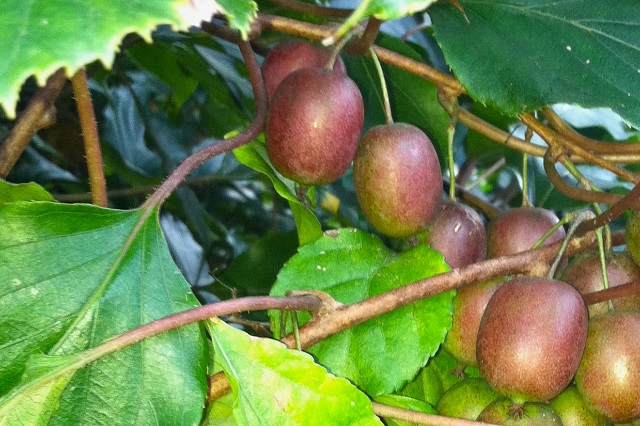
Submitted by Holly S. Jones, manager of the Kitchen Garden at the UT Gardens, Knoxville
When I first learned that you could grow kiwis in Tennessee, I had a hard time believing it. Real kiwis? That you can eat? The answer is yes. Actinidia arguta, or hardy kiwi berry, is a delicious cold hardy true kiwi that can be grown in USDA plant hardiness zones 4-8. Not to be confused with the brown fuzzy kiwi (Actinidia delicosa), this vigorous woody vine produces a lovely smooth skinned small kiwi fruit about the size of a large grape. They taste like a very sweet kiwi with a thin edible skin. Higher in vitamin C than oranges, they also provide a healthy package of other immune-boosting antioxidants, fiber and essential minerals.
The vine is native to the mountainous regions of Northern Asia. In China the fruit is often pickled in brine. Commercial production in the U.S. has been slow to develop because of its relatively short shelf life and the labor cost of hand harvesting and annual pruning. But for the home gardener who is able to provide a well thought out space, a supporting structure and regular maintenance, the kiwi berry is an edible jewel.
Most A. arguta are dioecious, which means male and female flowers are produced on separate plants. For fruit production you will need at least one male for every nine females. The commonly recommended spacing is 10 feet to 16 feet between plants with a maximum distance of 30 feet between pollinating pairs. Hermaphroditic varieties, such as ‘Issai’, are sold as self-pollinators, but they will yield much more reliably with a male planted nearby. Male plants tend to be less hardy than females and may require winter protection, such as burlap wrapping, until they reach maturity. Russian cultivars like ‘Anna’, ‘Tatyana’ and ‘Natasha’ are gaining popularity for their hardiness and productivity.
While kiwi berries are grown successfully in areas with winter temperatures as low as -25°F, there can be winter complications even in our milder climate. Just like most fruiting plants, the fruit buds are more susceptible to winter injury than the leaf buds, so you may lose a crop one year but see no visible damage to the plant. When winter temperatures fluctuate drastically over a short period of time, even if the lowest temperature reached was well above the standard hardiness prediction, this stress can lead to damage and even death of many fruit crops, hardy kiwi included. Plants that are well cared for and are situated in ideal planting locations are more likely to endure climate pressure.
For maximum fruit production and general plant health, plant in deep, fertile, well-drained soil with full sun exposure. To prevent fruit bud damage from late spring frosts, look for a planting site with northern exposure. This will help to ensure that the plant stays dormant until warm weather has truly come to stay. It’s important to keep them well watered, especially in the summer, but make sure the water drains freely as they will not tolerate wet feet. Raised beds and large containers (15 gallons or greater) can be used with success. It may take 4 -5 years for the plants to produce fruit but once they reach maturity, each plant can produce 60-100 pounds of sweet, flavorful fruit per year. The berries are harvested in mid to late October when most other fruit crops are long gone.
Though I have seen these kiwis grown as a large, ranging shrub hedge, the best way to collect the fruit is to train them onto a strong trellis system or some other sturdy support. Expect to prune a few times during the year. During the summer, thin excess shoots to increase sun exposure and trim remaining flowering shoots back to about five leaves beyond the last flower. Late winter pruning is done to remove last year’s fruiting canes and any dead or diseased wood. Abandoned or neglected plantings can grow out of control and may require pruning all the way to the ground. New growth can then be trained properly.
The cultivars Tatyana and ‘Meader’ were planted in the fall of 2014 on the main arbor in the Kitchen Garden at the UT Gardens, Knoxville. Come by and check out their progress!
Holly S. Jones manages the Kitchen Garden at the UT Gardens, Knoxville. The University of Tennessee Gardens located in Knoxville, Crossville and Jackson are part of the UT Institute of Agriculture. Designated as the official botanical garden for the State of Tennessee, the gardens’ mission is to foster appreciation, education and stewardship of plants through garden displays, educational programs and research trials. The gardens are open during all seasons and free to the public except during designated special events. For more information see utgardens.tennessee.edu
Contact:
Patricia McDaniels, UTIA Marketing and Communications, 615-835-4570